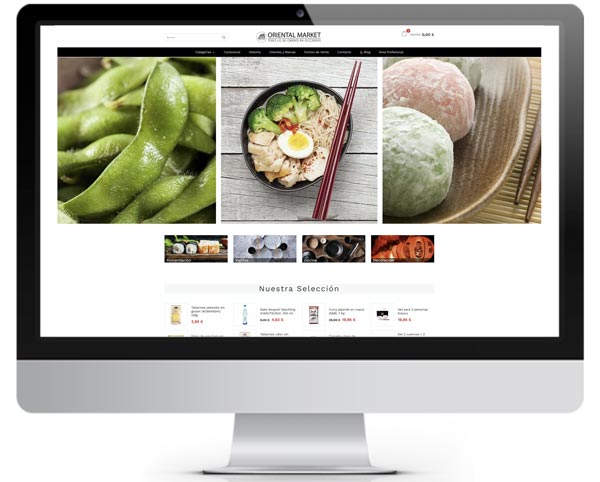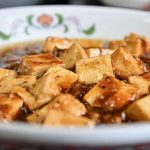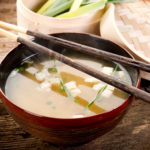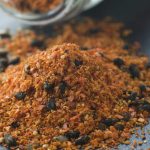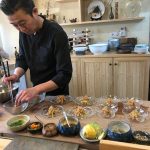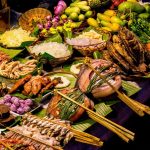Teriyaki Sauce: What it is, recipes and where to buy it
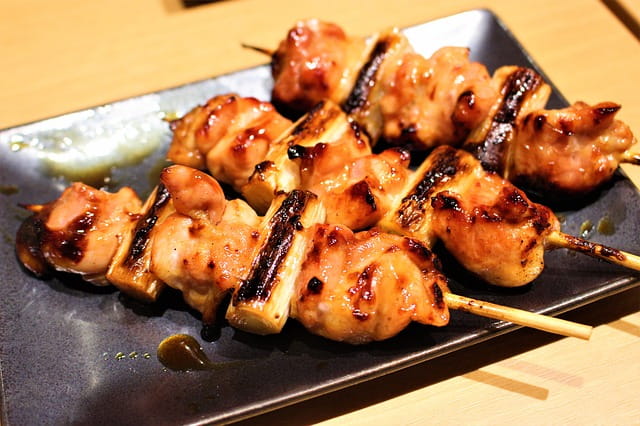
Teriyaki sauce is one of the star condiments of Japanese cuisine, and has also been very popular in the West. It is generally known as a sweet-tasting seasoning, but it is actually a gastronomic technique, whose name is the result of the combination of the terms “teri”, which translates as “shine”, and “yaki”, which means “grilled”. For this reason, dishes seasoned with teriyaki sauce are characterised by their brightness and caramelised tone.
What is teriyaki sauce (preparation, seasoning)?
Teriyaki sauce is a condiment made up of four main ingredients: soy sauce, sake, mirin and sugar.
As many of our readers will know, sake is one of Japan’s most popular alcoholic beverages, made by fermenting rice in a process similar to that of beer. Mirin, on the other hand, is another type of rice wine, but sweeter and lower in alcohol content than sake. Sake and mirin are products that can be purchased in one of our shops in Barcelona or Madrid selling Asian and gourmet products. Another good alternative is to buy them online at a good price in our online shop.
The preparation of the teriyaki sauce is very simple: mix the sake, mirin and soy sauce in a saucepan and put it over a low heat. Then add the sugar, stirring until completely dissolved. Let the sauce simmer until it is reduced and has a slightly thick, viscous texture. However, it will be the consumer himself who will obtain a greater or lesser level of thickening depending on his taste.
The proportion of each ingredient also varies according to taste, but it is usual to prepare Teriyaki sauce with three measures of mirin, three measures of soy sauce, one measure of sake and one measure of sugar.
Nowadays, there are many variations of this sauce. In fact, ready-made sauces marketed under the name teriyaki usually include other ingredients, such as sesame, ginger, garlic, lemon or orange peel zest, pineapple juice, etc.
This sauce is generally used to marinate or season meats, poultry and fish before grilling. It is recommended that the fish be intensely flavoured – such as tuna or salmon – so that the sauce does not totally eliminate the flavour of the fish.
If you want the grilled product to have an intense sauce flavour, it is advisable to continue adding sauce (with a brush) while the grilling is finishing, or even to add a final coat once it has been removed from the grill. Among the most typical and well-known recipes in the West are chicken teriyaki (usually served as a skewer), beef teriyaki and salmon teriyaki. Accompanied with rice – boiled or fried – it is a dish that will satisfy everyone, even children.
Apart from accompanying meat and fish, teriyaki sauce is also used as a condiment for vegetables and wok noodles, among other foods.
Buy teriyaki sauce online
[imacPrestashop_categorias cant_productos=”9″ categoria=”185″ idioma=”1″]Japanese recipe: teriyaki chicken
Japanese recipe for teriyaki chicken
Origins
The origin of teriyaki sauce is thought to date back to 17th century Japan, although other hypotheses suggest that it originated outside the Japanese archipelago.
On the other hand, other theories suggest that the sauce is a creation of early Japanese immigrants who settled on the island of Hawaii, who made a distinctive condiment from local products such as pineapple juice, mixed with soy sauce.
Therefore, its actual origin is unclear, but what is clear is that it has been called teriyaki since ancient times because of its cooking method.
What is the taste of teriyaki sauce?
Teriyaki sauce is used to enhance the flavour of dishes and stimulate the senses for a pleasurable tasting experience.
Teriyaki sauce has a slimy texture and a distinctive sweet and spicy taste. As mentioned above, the flavour of the sauce can vary depending on the ingredients used and their quantities. However, teriyaki sauce has a predominantly sweet taste, providing a very special and tasty touch to grilled meats, which acquire more aroma and a more intense flavour.
In fact, this sauce is used to add extra flavour by infusing the cooked food with the sauce. It is also perfect as a substitute for oil or butter when cooking in a frying pan, as the sauce itself prevents the food from sticking.
What is Sriracha sauce: origin, recipes and where to buy it

What is Sriracha sauce
Sriracha sauce is a delicious traditional Thai condiment that is becoming more and more popular in Western cuisine, especially in its North American version. Sriracha sauce originates from the Thai town of Si Racha, from which it takes its name. The main ingredients used to make it are red chilli paste and Thai red chilli peppers, to which vinegar, salt, garlic paste and sugar are added. In addition, it undergoes a fermenting and steeping process, hence it is also called fermented chilli. The result is a sauce with a thick texture and an intense, spicy, yet slightly sweet flavour that has won over millions of palates.
Buy Sriracha sauce online or in our shops
You can buy any of the different brands and variants of Sriracha Sauce we have in our online shop or in our shops in Madrid and Barcelona.
[imacPrestashop_categorias cant_products=”9″ category=”186″ language=”1″]
Origin
There are several theories about the real origin of this Thai sauce. For example, it is said that the first person to make Sriracha sauce was a woman named Thanom Chakkapak who lived in the city of the same name.
Meanwhile, according to the Si Racha Lovers Association, the beginnings of Sriracha can be traced back to Burmese sawmill workers who would go to a small shop in Si Racha to buy chillies, vinegar, salt and sugar. They would then mix them in a mortar and pestle to make a sauce. The shop owner, known as Ah Pae, took the Burmese workers’ recipe and started making it herself to sell in her shop. Later, another customer started buying large quantities of the ingredients needed to make it, and marketed it under the name Sauce Si Racha Traa Phukhao Thong.
It is also said that Sriracha sauce was a culinary creation of La Orr Suwanprasop in the 1930s. A native of Su Racha, La Orr married a Bangkok man and the two moved to Bangkok, where they decided to market the sauce, which spread throughout the country.
Be that as it may, what is clear is that Sriracha sauce comes from the city from which it takes its name, located in Southeast Asia, and today it is known almost all over the world, especially in the United States, where it has become a social phenomenon. The success of Sriracha sauce in North America is linked to a Vietnamese immigrant who founded the company (Huy Fong Foods) that produces the most widely consumed brand of Sriracha sauce in the United States. In fact, many consumers call it “rooster sauce” because of the image of a rooster on the packaging.
How to serve the sauce
In Thailand, Sriracha sauce is often served with seafood and vegetables, but its use as a condiment has been extended to many other foods. The spicy sauce has come to prominence in fast food outlets around the world as well as in restaurants with a fusion cuisine. Of course, there are also many households that make it at home, or buy it ready-made under some of the available brands. As we mentioned earlier, the most popular brand is that of El Gallo, which belongs to a company based in the United States, but which also distributes it in the European and Spanish markets.
If you choose to prepare it, you can store it in airtight jars to keep it preserved and available all year round. Moreover, if you mix it with tomato concentrate, you can have a milder variant to add to pizzas, pasta recipes or meat stews. It is also commonly used as a condiment for sandwiches, burgers, scrambled eggs, Chips, chicken wings, etc.
Sriracha sauce recipe
Make your own homemade SRIRACHA (SPICY SAUCE)
Ingredients for homemade recipe:
2 dessert spoons of brown sugar.
80ml white wine vinegar
8 cloves garlic
4 jalapeño peppers
A few hot chillies
4 sweet peppers (optional)
1 red pepper
Seaweed for sushi: types, recipes and where to buy it
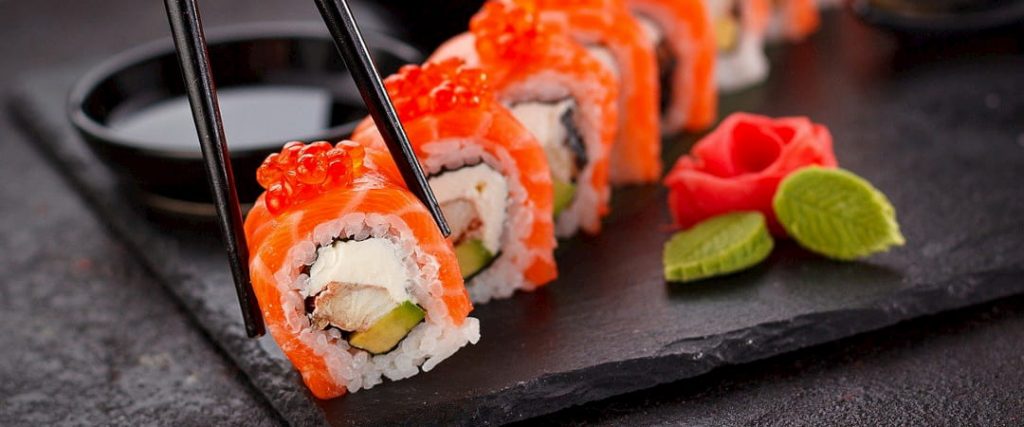
In recent months, many people have been encouraged to try Japanese cuisine at home. In this sense, traditional recipes such as sushi have become the star dish for special lunches and dinners. Because it is one of the favourite dishes of adults and children, because it is fun to prepare and the youngest members of the household take part in its preparation, because we want to surprise our guests, etc… Whatever the reason, sushi has become one of those dishes that helps us to create unique and appetising moments with our family and friends. But do we know everything about this dish? Apart from nori seaweed, what types of seaweed can we use to make sushi? What use can we make of each of them to create different and healthy dishes?
What type of seaweed is used for sushi?
The most common answer: nori seaweed. And rightly so. Undoubtedly, nori seaweed is the seaweed par excellence of this dish made in Japan. But is it the only seaweed? No. There are others, which we will mention below and which we will highlight in order to discover how to get the most out of our sushi.
Nori seaweed, the best known seaweed in Japanese cuisine, stands out for its small, thin size and because it changes colour from black to green when it has been cooked. It is a seaweed that comes from cultivation and is dried in the sun or in the oven on bamboo mats for use in sushi. After this traditional drying, the seaweed is treated in sheets, and is distinguished by a rougher texture on one side and a smooth texture on the other. A flexible seaweed that we can mould to roll our makis. This seaweed can now also be found in snack format or as a dressing for our salads or oriental pasta dishes, or furikake, as well as an accompaniment to miso soup. It is undoubtedly the star seaweed!
But as we said, it is not the only seaweed that can be used to make sushi. For the preparation of this tasty dish we can use other versions such as: wakame, also very common in salads. This type of seaweed stands out for its intense green colour and can be found fresh or dried. When wakame seaweed is fresh, it stands out for its gelatinous texture due to its high water content. From a nutritional point of view, we can say that wakame seaweed has great benefits in terms of proteins and carbohydrates, as well as calcium and folic acid. Although, as we have said, it is usually presented in salads and as an accompaniment to sushi, it can also be used as a filling. This is how it is presented in an original recipe from Senen’s Kitchen: Foie and Wakame Seaweed Sushi.
Other seaweeds that can also be used for sushi or as a side dish are:
Tengusa seaweed: an essential seaweed in the preparation of the well-known agar-agar. This type of seaweed stands out for its yellowish to reddish colour, and because it can be eaten either hot or cold. Another seaweed that is also essential for the production of agar-agar is the ogonori seaweed. Both seaweeds are commonly found in fried versions of sashimi dishes.
Arama seaweed: Noted for its dark colour, sweet taste and somewhat crunchy texture, as well as its high nutritional content in iron, calcium and iodine. To consume it, it is essential to soak it for 20 minutes beforehand.
Hijiki seaweed: It is characterised by growing in size after soaking. It is usually served with carrots and soy sauce. Both can be found as a sushi topping or as part of a side dish or salad.
Tosaka seaweed: If we continue with the list of the TOP seaweeds for sushi, we also find among them the tosaka seaweed, also known as the cockscomb, which can be found in green, red or white. This type of seaweed stands out for its thick and curly stems, very common as a garnish for sashimi.
Suginori seaweed: This type of seaweed is thinner and more branched than the seaweeds mentioned above. It is also very common as an accompaniment to sashimi.
Pyropia tenera seaweed: We also want to mention this minimalist seaweed, also known as gim, a type of nori seaweed that stands out for its small size, reddish colour and delicate texture.
Buy online
[imacPrestashop_categorias cant_productos=”9″ categoria=”173″ idioma=”1″]Recipes with seaweed for sushi
We show you some of the most popular, easy and tasty sushi recipes that incorporate seaweed:
How to make HOMEMADE SUSHI step by step with nori seaweed.
How to make Sushi at home: California Roll and Maki Sushi wrapped with seaweed
How is authentic Sushi prepared in Japan?
How is seaweed used in the preparation of sushi?
As we have seen in the previous section, seaweed can be found in different ways when eating sushi. If we refer to the most common seaweed when rolling sushi, this is undoubtedly nori seaweed. This type of seaweed can usually be found in our online shop in packs of 10 sheets. To do this, simply place the sheet of nori seaweed on a mat and cling film, always with the rough side facing upwards. We then place the sushi rice and the vegetables or fish or other ingredients that we will use as fillings for our preparations. The nori seaweed, in its topping or snack version, can also be used to decorate our sushi.
We can use wakame seaweed for the filling. In this case we will be very discreet with the use of quantities. Just place a small amount inside, always in a horizontal position, just after the rice. We will place them close together so that they are pressed together when we roll up our sushi. The rest of the seaweed, which we can use as an accompaniment to our salads or with the sashimi, should be applied delicately to give that touch of sea flavour to our recipe at the top of the sushi, together with the wasabi (for example).
Nori seaweed: properties, benefits and where to buy it
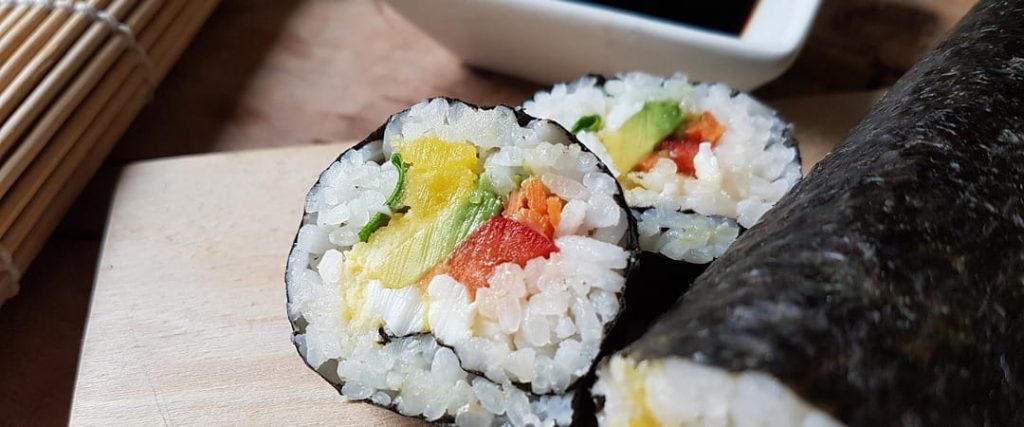
A few days ago we talked about the types of seaweed that can be used to prepare sushi, and now we want to focus on one of them, the most common: nori seaweed. Why “nori”? Nori” is a Japanese term used to refer to the edible varieties of seaweed. And by “nori seaweed” we mean the sheets of seaweed that are commonly used for making sushi. However, as we have already learned, food innovation has made it possible to find this ingredient in many other formats and presentations, such as snacks. Below, we will discover its nutritional properties, its health benefits and where we can buy this type of nori seaweed.
Properties of nori seaweed
Also known as “sea ovo”, nori seaweed is an excellent source of vitamins, minerals, proteins, carbohydrates and chlorophyll. We know that seaweed is one of the healthiest ingredients par excellence, which is why it is always present in the vast majority of the world’s cuisine. Without going very far, we find it in Galician cuisine. For this reason, its consumption in Japanese culture exceeds all expectations. Nori seaweed is a very versatile food that can be found in sheets or flakes. In this sense, the seaweed is used not only to roll sushi, but also as an ingredient in salads, as a topping in miso soups (a very common dish in the autumn-winter season) and finally as a snack. A snack that many have incorporated into their daily diet. It is also a highly recommended ingredient for the diet of sportsmen and women.
To benefit from the properties of nori seaweed, we must be able to recognise a quality seaweed. In this regard, experts recommend taking into account: its origin and cultivation, its texture (a good seaweed must be homogeneous), its intense green colour, its drying (we must not forget, as we mentioned previously in one of our articles, that this type of seaweed is treated by baking at a high temperature to achieve that dry, crunchy touch with a rough, smooth layer on one side and the other) and its intense shine. The fulfilment of these characteristics will confirm that we are dealing with a good quality nori seaweed and that therefore its properties are maintained.
Buy nori seaweed: prices and various presentations
[imacPrestashop_categorias cant_productos=”9″ categoria=”173″ idioma=”1″]Benefits of nori seaweed
When nori seaweed is of good quality and meets the properties mentioned above, we can say that we will have some healthy benefits for our body. As a source of vitamin A, we will be helping the formation of mucous membranes, health of our eyes, skin, nails, hair, teeth and bones; as vitamin B, among which we find the B1, B2 and B3, we will help a good metabolism and proper functioning of the nervous system; vitamin C, will be necessary for our welfare and especially in the coldest season of the year. Nori seaweed is also rich in minerals (calcium, iodine, iron, potassium and magnesium), proteins, carbohydrates and chlorophyll. It is therefore an ideal food for: the elimination of body fat, prevention of arteriosclerosis, as an aid against hypertension and asthenia; it is a digestive ingredient, which also helps to strengthen nails and hair, as well as allowing the elimination of heavy metals from the body such as mercury. Finally, it is also said to be a food that helps to improve thyroid activity.
Where is this seaweed grown?
The nori seaweed par excellence is cultivated in the seas of Japan. In particular, the most renowned areas for this type of cultivation are the Ariake Sea, known as the largest salt marsh in Japan, a small sea located on the island of Kyushu; and the Seto Inland Sea, a sea in the south of Japan that separates the islands of Honshu, Shikoku and Kyushu. Both areas are noted for their great biodiversity and are home to some of the best nori seaweed in the world.
If we have to talk about two key factors for the good cultivation of nori seaweed, these would be the water temperature and the sustenance/feeding of the seaweed. With regard to temperature, experts confirm the importance of not exceeding 23 degrees Celsius. Unfortunately, climate change is not making it easy. Every year the temperature of the Pacific Ocean rises, which means a progressive warming of the water and therefore a shortage in the proliferation of this type of algae in the aforementioned areas. On the other hand, fertilisers. Good agricultural practices are leading to a reduction in the use of fertilisers in the fields, an essential element for the feeding of seaweed. For cultivation, nori seaweed is hung on poles and allowed to grow in the wind in order to enhance its flavour. The ideal time for cultivation is during the cold winter nights.
How the nori seaweed for sushi is made
Interesting video from the DMAX channel, where we can see how nori seaweed is cultivated and the route it takes from the sea to our kitchens.
Nori seaweed recipes
We show you some recipes with nori seaweed:
Onigiri easy recipe
How to make homemade Japanese sushi and cook the rice
Nori seaweed sandwich
Find out all about Yakiniku
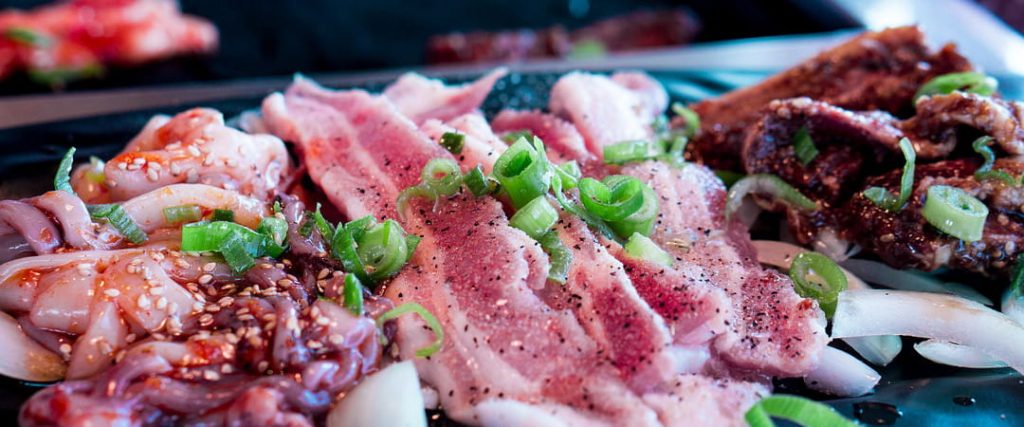
If you go to Google and type in “Yakiniku” you will probably have found thousands of articles that refer to this Japanese word. However, the doubt arises when you read them and see that some of them refer to a type of dish, others to a style of cooking and others to a specific sauce, to give some examples… Which is the right choice? I don’t want to discourage you, but in reality, they are all correct. The word “Yakiniku” has become a trend and is used to refer to the ingredients and recipe of any grilled meat dish in Japanese cuisine. A style of cooking meat in chunks to which a special sauce is usually added. This week, from Oriental Market, we want you to know ALL about yakiniku and its incorporation to some of the best restaurants in our country:
Find out all about this dish
When we mention Yakiniku in Japan, we are dealing with what is accidentally known as “barbecued meat”, but which stands out for its very different peculiarities. Yakiniku is an assortment of meats that are always of very good quality, finely sliced and cut into small pieces. This is important because in oriental cuisine, chopsticks are commonly used. It should be noted that in addition to meat, vegetables can be found more and more often in a “Yakiniku”, as in any typical western grill, as well as seafood. The finishing touch to this delicacy comes with the sauce of the same name, Yakiniku sauce.
Have you ever travelled to Japan and been to a Yakinuku restaurant? They are characterised by including a small charcoal brazier in the middle of the diners’ table where customers can grill the raw meat directly and get it to their liking in 30/60 seconds. The menu includes a wide range of meats so you can choose the one you fancy or try local delicacies such as “beef tongue steaks” or the exquisite Kobe beef. It is a fun time to enjoy even more the preparation of the ingredients of this gastronomy.
To accompany the meats that are usually grilled in Japan, vegetables or cereals such as rice or corn can be used. Among the most common vegetables we can find: aubergine and courgette, tomatoes and peppers.
Buy Yakiniku sauce at our online shop
imacPrestashop_products products=”3079,5540″ language=”1″]
Origin of Yakiniku
The origins of this dish date back to the Second World War. There is a commonly accepted theory that yakinuku is formerly known as “horumon-yaki” (leftover grilled beef or pork), which was introduced to Japan by Korean immigrants. Later, the stalls known as “Horumon-yaki” were those where the pork loin and ribs were used, and which have now become well-known restaurants. Undoubtedly, this dish has been a rising trend throughout history as it went from being a #streetfood dish to become the delicatessen of restaurants that either include this dish in their menu or are dedicated exclusively to it.
Being a native Japanese dish that came to Korea later, there are two different ways of preparing it. While the Korean version is characterised by marinating the meat before grilling it (always using Yakiniku sauce), in the Japanese version it is the opposite, the meat is presented raw and “dipped” in sauce before eating. Now, this dish has landed in Spain, ready to delight the most exquisite palates and to create a unique and shared experience in oriental restaurants.
Best Japanese restaurants in Barcelona

If you’re passionate about Japanese cuisine and you’re from Barcelona, you’re in luck. Eating with chopsticks is all the rage, which is why Barcelona offers a wide range of restaurants to suit all tastes and budgets. Among its streets and charming corners you will find the most typical dishes of Japanese culture: sushi, ramen, fish, miso soups, mochis… In order to make your job easier and allow you to embark on a trip to the land of the rising sun without leaving the city, we propose a list of the best Japanese restaurants in Barcelona.
List of the best Japanese restaurants in Barcelona
The best ramen: Ramen Ya-hiro
Carrer de Girona, 164
Phone: 930028441
Ramen is one of the star dishes of Japanese cuisine. This iconic homemade broth is usually made from chicken, pork or dried fish. It is accompanied by sauces that define its flavour, such as miso or soy, and noodles and toppings such as meat, tamago mushrooms are added. The Ya-Hiro restaurant is a small, cosy establishment in the city that specialises in ramen and is the main reason why it has become popular in Barcelona. Now that the cold weather is getting harder, you couldn’t be more in the mood for a hot bowl of soup to warm you up.
For those with a sweet tooth: Akashi Gallery
Carrer Rosselló, 197
Telephone: 931250877
Akashi Gallery Barcelona is a sushi bar and photography gallery created by Tina Bagué and Toru Morimoto, expert photographers and lovers of Japanese culture. However, the restaurant was born as a traditional tea shop, so it stands out for its homemade desserts. On the menu you will find a variety of typical sweets such as Nutella dorayaki, matcha tiramisu, tofu cheesecake, yuzu fondant or original mochis in different flavours.
Best value for money: Kiku Chan
Carrer Numancia, 33
Telephone: 934107247
An unpretentious restaurant offering a varied and extensive menu of delicious Japanese dishes at an unbeatable price, that’s Kiku Chan. The place is small, tavern style, and not very well decorated, but don’t be fooled. You know what they say… the best is on the inside. In this case, inside the kitchen.
Avant-garde: Koy Shunka
Carrer d’en Copons, 7
Telephone: 934127939
Located in the emblematic Barrio Gòtic, Koy Shunka is the first restaurant in Barcelona to be awarded a Michelin star. Its chef and owner, Hideki Matsuhisa, is considered the Japanese Ferran Adrià for offering fresh ingredients in refined but, above all, very tasty dishes. It also offers the possibility of trying a tasting menu, which is a spectacle of oriental flavours. If you are looking for elegant, high-level gastronomy, Koy Shunka is your best option.
The eternal: Yamadori
Carrer d’Aribau, 68
Telephone: 934539264
Opened in the 1970s, Yamadori restaurant is considered the first Japanese restaurant in Barcelona. Located in the heart of the Eixample district, this restaurant is decorated in the typical Japanese style with a sushi bar and offers a wide range of traditional Japanese dishes. Its most outstanding feature is simple: its authenticity. After more than 30 years of history, it still retains the same decoration and structure as the day it opened its doors for the first time. Thank you Yamadori for showing us the most symbolic gastronomic jewels of your culture.
A modern tavern: Can Kenji
Carrer del Rosselló, 325
Telephone: 934761823
Can Kenji is a restaurant inspired by traditional Japanese taverns, the izakayas. An izakaya is a typical place in Japanese culture where you can eat small portions of the most popular dishes, or in other words, tapas. It is the perfect place to go for a drink after work, relax and have a good time. Since its opening in 2010, the Can Kenji tavern has not stopped offering the most classic flavours of this gastronomy along with some more creative Mediterranean-inspired dishes. An infallible tandem of the most authentic traditional recipes and avant-garde Mediterranean cuisine.
Fusion: Casa xica
Carrer de la França Xica, 20
Telephone: 936005858
Duck confit gyozas, mussels with coconut broth, calçot kimchi, fresh fish of the day with red curry or Iberian secret with oyster sauce are some of the dishes you can find at Casa Xica. Does that sound strange? That’s because these dishes are the result of a fusion of the gastronomic treasures of Catalonia and Asia. The restaurant was founded by three Catalan partners, who, on a trip to Malaysia, were captivated by oriental gastronomy and were inspired to open their business. As its name suggests, Casa Xica is a small and intimate place where you can enjoy the exotic flavours of Asian food prepared with the best fresh Mediterranean produce.
Do you want to make some of the dishes from these restaurants at home?
Many of them buy the products, ingredients and raw materials in our shop in Barcelona or online, imported directly from Japan. Among the most popular ingredients are soy sauces(of which we have a wide variety: gluten-free, light, for gyozas), some of the best sake in the world and all types of seaweed (nori, kombu, agar agar…).
Telephone: 931250877
Telephone: 934107247
Telephone: 934127939
Telephone: 934539264
Telephone: 934761823
Telephone: 936005858
Best Japanese restaurants in Madrid

Japanese food is one of those things that you either love or hate. Well, if you are of the first group and you are in Madrid, you should know that it is one of the best places to experience the most characteristic flavours of Asian cuisine. The capital is one of the country’s gastronomic hubs and for this reason it is home to a large number of restaurants. With so many options, it can be difficult to choose where to go, so here is a list of what we consider to be the best Japanese restaurants in the city. Start your tour of the most Japanese Madrid!
List of the best Japanese restaurants in Madrid
The one with the Michelin star: 99 Ko Sushi
Calle Marqués de Villamagna, 1
Telephone: 914313878
99 Ko Sushi is a restaurant located in the Salamanca neighbourhood that stands out for having always sought high quality. And it is thanks to this that it has become a Japanese restaurant for the most demanding palates. Its young chef, David Arauz, has managed to make the most of the most select products and cook them with the techniques of true Japanese culinary art. The restaurant offers two types of set menus: the Omakase and the Kaiseki, which differ from each other in that the latter has a few more dishes. Both options are perfect and allow you to enjoy the textures and flavours of brioche, sashimi or robata. Awarded a Michelin star, 99 Ko Sushi is one of the most exclusive Japanese restaurants in Madrid.
The most hooligan: Umiko
Calle de los Madrazo, 18
Telephone: 914938706
Umiko is a very daring and fun Japanese fusion restaurant, that’s how Umiko defines itself. Its chefs, Pablo Álvaro and Juan Alcaide, have managed to combine Japanese and Spanish cuisine, squeezing the best of each. Umiko’s cuisine is very focused on the raw ingredients, but always adding a creative touch with the craziest fusions you can imagine: have you ever thought of combining Cuban-style rice with sushi, or nigiri with socarrat paella? What’s more, the décor of the place is totally faithful to the essence of the restaurant: graffiti and manga-style murals that create a modern, underground atmosphere.
For all budgets: Yokaloka
ANTÓN MARTÍN MARKET, Calle de Santa Isabel, 5
Telephone: 610602722
Yokaloka is a small Japanese restaurant located in the Mercado de Antón Martín. Despite being a modest stall of small dimensions, it offers a variety of high quality dishes at an affordable price. Because let’s not be fooled… Japanese food is usually expensive. One of its specialities is ramen, although it is only served on Tuesdays and Wednesdays. The rest of the menu is quite simple and traditional, but that’s the key: to offer few dishes, quality and at a good price.
The place to go: Balón Tokio
Calle de Echegaray, 29
Telephone: 914296509
Balón Tokio is a small bar-style restaurant where takoyaki is prepared. And what is takoyaki? Well, it is basically a fritter stuffed with a piece of octopus and ginger inside and served with different sauces. It is very popular in Japanese street food, but in Madrid there are still no places specialising in this dish. Balón Tokio is the first and only one, although probably not for long.
Cinematic sushi: Sushi Bar Hannah
Calle Marqués de Villamagna, 1
Telephone: 911049687
Eat sushi while you enjoy a film. Sounds like a great plan, doesn’t it? Sushi Bar Hannah has two cinemas inside and every fortnight they organise events where they show a film accompanied by sushi snacks and a drink. The rest of the days, it is a Japanese tavern where chef Janek Flemyng offers dishes that will not leave you indifferent. They are not simple, on the contrary. From the dishes to the crockery itself, they reflect a sublime delicacy and elegance.
Balanced and ethereal: Miyama Castellana
Paseo de la Castellana, 45
Telephone: 913910026
If you are looking for Japanese food in the financial centre of Madrid, Miyama Castellana is your restaurant. Odaka and Hiroshi Kobayashi are the ones who have managed to capture the true essence of the Japanese country and represent it in the form of dishes. In this restaurant you can enjoy a cuisine totally inspired by tradition, with few western accents but with a touch of fusion. In addition, Miyama Castellana’s menu offers options that go beyond the typical and recurrent sushi, which are still unknown to the majority of the European public.
And finally… the dessert: Wagashi Utanane
Calle Andrés Mellado, 43
Telephone: 919216921
For those who always leave room for dessert, Wagashi Utanane, a pastry shop with authentic Japanese sweets served with the best teas. Daifukus, Mochis, Chiffon Cake and Dorayakis are just some of the dishes you can try. Despite the popularity of Japanese cuisine in Spain, sweets continue to be its most unknown facet. If you are one of those who have not yet discovered it, come and let yourself be carried away by this refined confectionery that will stimulate all five senses.
Would you like to make some of the dishes from these restaurants at home?
Many of them buy the products, ingredients and raw materials in our shop in Madrid or online, imported directly from Japan. Among the most popular ingredients are noodles and oriental noodles (of which we have different varieties: wheat, rice, gluten-free…), numerous sauces to accompany them (teriyaki, soy, sweet and sour, oyster) and alcoholic beverages such as sake.
Shiitake mushrooms: what they are, properties and recipes
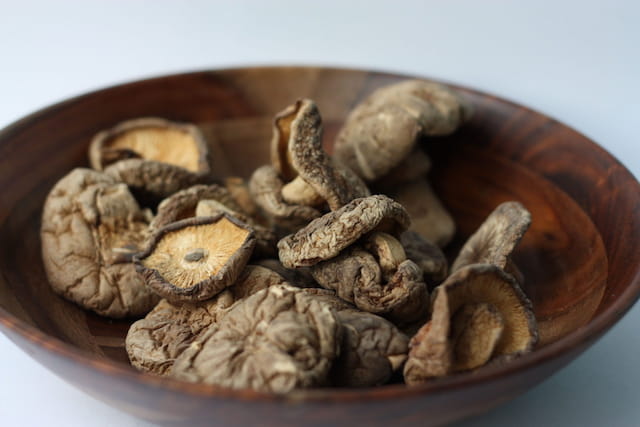
Shiitake mushrooms have been considered a revered food in Japan and China for more than 2,000 years. Today, along with soya and sushi, it is the most common oriental food in Western dishes. Shiitake has probably become the most popular and cultivated Asian mushroom in the world. But what makes them so special? The reason why this small fruit is so important in their culture is because of its multiple health benefits. Its medicinal properties in combination with its intense flavour and smoky aroma have been the key factors why this mushroom is now a “must” in any kind of cuisine.
What are they?
The word “shiitake” is a Japanese word derived from “shii”, a variety of oak on which this type of mushroom usually grows, and “take”, which means mushroom in Japanese. Shiitake mushrooms are brown in colour, darker in the centre and lighter on the outside. They are easy to recognise by their large cap, which can be up to 25 centimetres in diameter. You can also tell them apart by their earthy aroma and their smooth, juicy texture, which is capable of enrapturing any palate.
This mushroom grows naturally twice a year, in spring and autumn, on the wood of certain trees such as oak, beech, eucalyptus or holm oak. It is also possible to grow it on natural or synthetic substrates, usually made from straw or sawdust. However, the most common way to find them is in dried form, although in Asian countries it is easier to buy them fresh. But be careful! It is important to bear in mind that if you use dried mushrooms, their flavour will be much more intense than in their fresh version and, therefore, the way to cook both versions is also different.
Find out where to buy them
You can buy shiitake mushrooms in our online shop or in our shops in Barcelona and Madrid.
[imacPrestashop_productos productos=”1032,123,3816,3976″ idioma=”1″]Properties
The first written reference to shiitake mushrooms dates back to the Sing Dynasty (960-1127), but it was not until the Ming Dynasty (1368-1644) that this mushroom began to be prescribed by doctors to treat liver diseases, regulate cholesterol, improve circulation and, in general, preserve health. Since then, this mushroom has been a constant feature in the history of traditional Chinese medicine. However, to this day it is still considered a food with great curative and preventive qualities, and can even be consumed in capsule form. Here is a selection of the main properties that have made this mushroom Asia’s best-kept secret for longevity.
Boosts the immune system
The medicinal properties of shiitake mushrooms are mainly due to one of its components: lentinan. This molecule is known to strengthen the immune system and defences against diseases such as cancer. In addition to being an immunostimulant, lentinan can reduce blood fat levels and the risk of thrombosis.
In relation to cancer treatment, many scientific studies have shown the power of shiitake mushrooms in the prevention and reduction of cancer cells. Specifically, in 2006, a study was carried out in Japan on breast cancer, the results of which showed that these mushrooms were capable of both causing cell death in cancer cells and slowing their growth.
Cardiovascular benefits
Shiitake mushrooms have the highest percentage of fibre of all cultivated mushrooms. Much of this fibre is made up of chitin, a carbohydrate found in shiitake that not only aids digestion, but also helps to control and improve cholesterol. For this reason, it is of great help to people with cardiovascular diseases or hypertension.
The mushroom of eternal youth
Can you imagine all the ingredients for perfect skin in a jar? Shiitake mushrooms are a rich source of minerals such as iron, calcium and magnesium. In addition, they contain nine essential amino acids and vitamins B and D2. The perfect cocktail for cell regeneration, healthy skin maintenance and prevention of premature ageing.
Recipes
There are many traditional and innovative recipes using shiitake mushrooms. We wanted to highlight 3 of them that I think you will like.
Ramen soup recipe (Shoyu Ramen)
Ingredients for 4 servings:
4 portions of Ramen noodles (125 to 150 g. per portion).
500 g. pork belly (for the Chashu pork)
4 eggs (for the marinated egg)
1 sheet of Nori seaweed (split into 4)
For the stock
3 l. water
1 kg. chicken bones
½ kg. pork bones
3 dehydrated Shiitake mushrooms
3 large pieces of ginger
2 spring onion stalks
1 carrot
1 head of garlic
For the Tare
300 ml. japanese soy sauce
150 ml. Sake
150 ml. Mirin
1 piece of alga seaweed(about 5 g.)
4 cloves garlic
3 thick slices of ginger
1 spring onion stalk
For the flavoured oil
50 g. spring onion
½ cup vegetable oil (about 120 ml.)
Japanese recipe for miso soup with vegetables and shiitake mushrooms
Ingredients:
Vegetable stock
Ginger
Miso paste
50gr Shiitake
30gr of courgette
30gr carrot
Black sesame
Shiitake a feira
Original recipe where we are going to substitute the octopus for shiitake mushrooms.
Ingredients:
2 potatoes
150 g shiitake mushrooms
1 teaspoon of wakame seaweed
1 piece of kombu seaweed
1 teaspoon salt
1 litre water
Coarse salt
Sweet paprika and hot paprika
Extra virgin olive oil
Best Japanese cakes and desserts
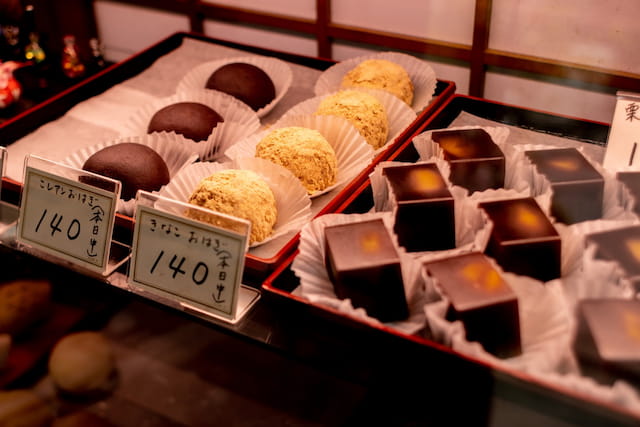
Japanese confectionery is a mystery: what are their sweets like, are they similar to those of the rest of the world? The truth is that the list of Japanese desserts is endless and you can find the most curious and incredible combinations of flavours. To begin to delve into this universe, the main (and most obvious) characteristic of Japanese confectionery that you should know is elegance. Japanese sweets express delicacy, perfection, detail and refinement, undoubtedly an apology to their culture. They are made as small works of art, as each one of them has a unique elaboration process.
Although sometimes in the West it may seem that Japanese dishes do not go beyond sushi and ramen, the truth is that Japanese cuisine is very varied. The Japanese take care of every detail in their cuisine, from the ingredients they use to the decoration, which is reflected in their dishes. This passion for fusing different flavours and textures is what has given rise to their wonderful pastry culture, a whole world of different sweets and cakes not to be missed.
Types of Japanese pastries
Wagashi
Wagashi are Japan’s traditional sweets to accompany the tea ceremony and play an important role in their traditional gift culture. The main difference with Western desserts is that they are not as sweet, their taste is much milder. They are usually made with an ingredient rarely used in Western desserts, the red bean, which also influences the sweetness on the palate. Their texture is usually firm so that they can be cut easily, but somewhat chewy so that they are soft to the bite.
In addition, the inspirational basis of Japanese desserts is undoubtedly nature. Their creations go hand in hand with the season of the year. That is why, generally, the shape of these pastries tends to be natural motifs such as flowers, leaves or fruits. For example, before spring, sweets may be made in the shape of cherry blossoms, before the trees bloom, in anticipation of their arrival.
The list of wagashi could be endless, so we have selected some of the most representative ones to introduce you to them:
Daifuku. This is one of the most popular sweets. Known in the West as “mochi”, this snack is made with rice flour and can be filled with different flavours, although the most common is anko or red bean.
Dango. This dessert can be found in almost any food stall in Japan. They are rice flour balls that can be presented in various ways. One of the most common is to stick them on a long chopstick, combining balls of different flavours or the same flavour, although it is also possible to eat them individually.
Dorayaki. No introduction needed. If you’ve ever seen Doraemon, you’ll know what we’re talking about. The famous cosmic cat was crazy about these sweets, which are nothing more than round sponge cakes filled with sweet bean paste.
Namagashi. This is one of the most beautiful and special sweets. Made from rice flour, it is characterised by reflecting the season in which it is served in both appearance and taste. The skilled confectioners who make them are considered artists, as learning to make and perfect them can take years.
Taiyaki. This is one of the most fun Japanese pastries because of its aesthetics, in the shape of a fish. Its most common filling is, of course, red bean paste. Its preparation is similar to that of a waffle: the batter is taken and poured into a mould in the shape of a fish. It is then baked on both sides until golden brown.
Cake culture
Most of the cakes found in Japan are of foreign origin. It was not until the Edo era that the country opened its doors internationally and began to bring in the cake culture. Since then, the Japanese have adapted cakes from the rest of the world and adapted them to their own style.
Less sweet and more creamy. These would be the two most relevant variations of Japanese cakes. In the land of the rising sun, excessive sweetness is not a taste that seems pleasant, so the touch of sweetness tends to be more moderate. And Japanese patisseries are also very popular for individual portions, which is advantageous if you fancy trying more than one of these delicacies. Are you a pastry lover? Then take note and take note because we are going to reveal the best cakes in Japan:
Cheesecake. This cake is known everywhere, but the Japanese version is famous for being VERY fluffy. The mixture of egg whites, milk, sugar and cream cheese results in a very light, soufflé-like cheesecake.
Baumkuchen. This dessert is shaped like a hollow cylinder. Its interior is made up of many thin layers which, when cut, show a pattern similar to the rings of a tree. Baumkuchen is usually served in very thin slices with vanilla ice cream and hot chocolate on top.
Swiss Cake. In Japan it is better known as “roll cake” and originates from Europe. It is an elongated, rolled and filled cake that is usually covered with jam or chocolate, like a gypsy’s arm. It is such a popular cake in the country that you can find specialised shops in every city.
Montblanc. A dessert made of different layers of sponge cake covered with chestnut paste to create a mountain resembling Mont Blanc, hence its name. Its origin dates back to France in the 1600s, although it did not reach Japan until its internationalisation in the 20th century.
What are dumplings: how to eat them and recipes?
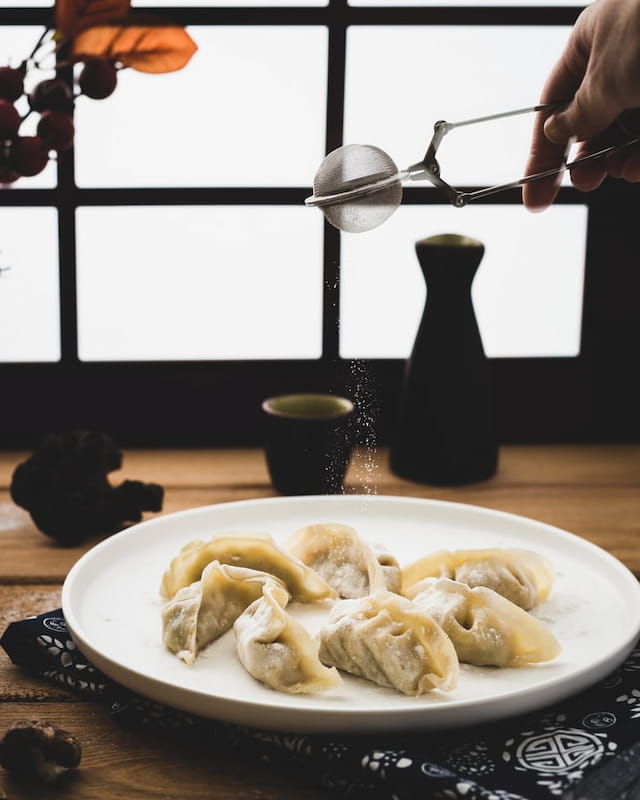
Dumpling, dim sum, gyoza, xiao long bao, wonton… No, it’s not a Japanese tongue twister. They are different names that you have probably seen on the menu of some Asian restaurant and that often generate so much confusion that even our friend Google is not able to solve. So that going to eat at a Japanese restaurant doesn’t become an odyssey, we leave you with this little basic guide to dumplings, the little snack from the East that has conquered the kitchens of the West.
What are dumplings?
To begin with, it is necessary to clear up the most widespread doubt: are dumplings and dim sum the same thing? The answer is no. Dim sum literally means “bite that touches the heart”, so they could be considered a kind of tapas or small plates of food. They are a tradition from Canton, a region in southern China, although they have spread throughout Asia. They can be eaten for breakfast, lunch or an afternoon snack, but not at dinner as we usually do in Western countries. They are most commonly eaten with tea.
umplings are a type of dim sum, representing typical Chinese food, as they are small dumplings filled with various ingredients, similar to a dumpling, and can be classified depending on the filling or shape. The dumplings are usually made with different types of flour such as wheat, rice and tapioca.
How are they eaten?
Now that you have been able to learn the basics, it is possible to move on to the next step of this guide: learning about the most prominent types of dumplings.
Jiao Zi, also known as gyoza in its Japanese version, are the most popular. They are characterised by their wheat dough filled with beef, courgette and ginger. They are usually cooked by boiling, although gyozas are grilled before serving. The type of closure is very similar to that of a dumpling.
Wonton. This type of dumpling is made with wheat flour and egg, and is usually filled with pork and prawns. They can be eaten in all sorts of ways, even as an accompaniment to soups. Their closure makes them look like tortellini or sachets.
Har Gow, the secret is in the dough. It is made from tapioca flour, which gives it a very characteristic consistency. The filling is usually prawns and it looks like a shell. It is one of the most difficult varieties to prepare due to the elasticity and thinness of the dough, which is almost transparent.
Siu Mai. It is very similar to wonton, as it is prepared with the same dough. However, instead of being in the shape of a closed sachet, it is open. This is because it is filled with a larger amount of dough, which makes it impossible to seal.
Xiao Long Bao, typical of Shanghai. Its traditional recipe is based on a bacon and crab filling that is wrapped in a dough made with wheat flour. However, the most peculiarity of this type of dumpling is that it has broth inside. There is also a ritual of eating the dumpling, which consists of picking up the morsels with chopsticks, piercing a hole in them, letting them cool and drinking the broth inside. Afterwards, the rest is eaten in one go.
Baozi. Baozi is a type of steamed dumpling with a slight variation from the previous ones, which is that a pinch of yeast is added to the dough. As a result, the dumpling is much fluffier, like a bun. The filling is usually meat with spices, but they can also be eaten sweet as a dessert.
Nem. These are typical of Vietnam and are eaten rolled in a rice wafer, although in some areas near China it is more common to eat them fried. They are usually stuffed with pork and prawns and served with lettuce leaves.
Recipes
How to make Kung Fu Panda Dumplings (Pot Stickers) – Recipe
How to Make Chinese Dumplings – How to Make Chinese Dumplings (recipe) 饺子
Ingredients:
500 grams (4 cups / 18 ounces) all-purpose flour.
265 millilitres (1 cup plus 2 tablespoons / 9 ounces) water (at room temperature)
About 4 cups (4 cups) dumpling filling, preferably


